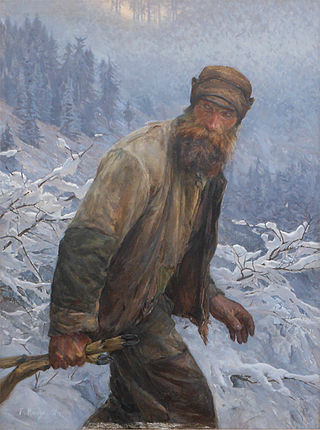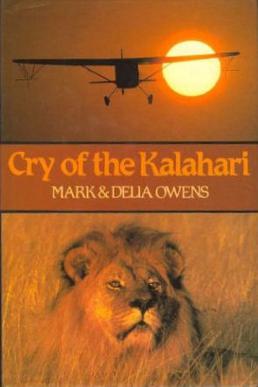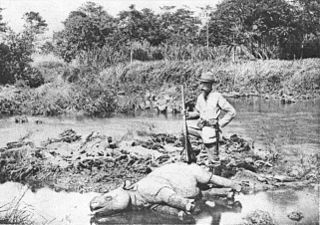Related Research Articles

Poaching is the illegal hunting or capturing of wild animals, usually associated with land use rights. Poaching was once performed by impoverished peasants for subsistence purposes and to supplement meager diets. It was set against the hunting privileges of nobility and territorial rulers.

Kruger National Park is a South African national park and one of the largest game reserves in Africa. It covers an area of 19,623 km2 (7,576 sq mi) in the provinces of Limpopo and Mpumalanga in northeastern South Africa, and extends 360 km (220 mi) from north to south and 65 km (40 mi) from east to west. The administrative headquarters are in Skukuza. Areas of the park were first protected by the government of the South African Republic in 1898, and it became South Africa's first national park in 1926.
North Luangwa National Park is a national park in Zambia, the northernmost of the three in the valley of the Luangwa River. Founded as a game reserve in 1938, it became a national park in 1972 and now covers 4,636 km².

Garamba National Park is a national park in the north-eastern Democratic Republic of the Congo covering nearly 5,200 km2 (2,000 sq mi). It is among Africa's oldest parks and was designated a World Heritage Site by UNESCO in 1980 for its protection of critical habitat for northern white rhinoceroses, African elephants, hippopotamuses, and giraffes. Garamba National Park has been managed by African Parks in partnership with the Institut Congolais pour la Conservation de la Nature since 2005.
Mike Bond is an American novelist, ecologist, war and human rights journalist, and poet.

The wildlife of Zambia refers to the natural flora and fauna of Zambia. This article provides an overview, and outline of the main wildlife areas or regions, and compact lists of animals focusing on prevalence and distribution in the country rather than on taxonomy. More specialized articles on particular groups are linked from here.
Odzala-Kokoua National Park is a national park in the Republic of the Congo. The park was first protected in 1935, declared a biosphere reserve in 1977, and granted official designation by presidential decree in 2001. Odzala-Kokoua has approximately 100 mammals species, and one of the continent's most diverse primate populations. The nonprofit conservation organization African Parks began managing the park in collaboration with the Ministry of Forest Economy, Sustainable Development and Environment of the Republic of the Congo in 2010.

Iain Douglas-Hamilton is a Scottish zoologist from Oxford University and one of the world's foremost authorities on the African elephant. In 1993, he founded Save the Elephants, which is dedicated to securing a future for elephants and their habitats.

The African bush elephant, also known as the African savanna elephant, is a species of elephant native to sub-Saharan Africa. It is one of three extant elephant species and, along with the African forest elephant, one of two extant species of African elephant. It is the largest living terrestrial animal, with fully grown bulls reaching an average shoulder height of 3.04–3.36 metres (10.0–11.0 ft) and a body mass of 5.2–6.9 tonnes (11,000–15,000 lb); the largest recorded specimen had a shoulder height of 3.96 metres (13.0 ft) and an estimated body mass of 10.4 tonnes (23,000 lb). The African bush elephant is characterised by its long prehensile trunk with two finger-like processes; a convex back; large ears which help reduce body heat; and sturdy tusks that are noticeably curved. The skin is grey with scanty hairs, and bending cracks which support thermoregulation by retaining water.
Cynthia Jane Moss is an American ethologist and conservationist, wildlife researcher, and writer. Her studies have concentrated on the demography, behavior, social organization, and population dynamics of the African elephants of Amboseli. She is the director of the Amboseli Elephant Research Project, and is the program director and trustee for the Amboseli Trust for Elephants (ATE).

The ivory trade is the commercial, often illegal trade in the ivory tusks of the hippopotamus, walrus, narwhal, black and white rhinos, mammoth, and most commonly, African and Asian elephants.

Cry of the Kalahari (1984) is an autobiographical book detailing two young American zoologists, Mark and Delia Owens, and their experience studying wildlife in the Kalahari Desert in Botswana in the mid-1970s. There they lived and worked for seven years in an uninhabited area named Deception Valley in the Central Kalahari Game Reserve. With no roads and the nearest civilization eight hours away they had only each other and the animals they studied as company, most of which had never seen humans before. Their research focused mainly on lions, brown hyenas, jackals and other African carnivores. Cry of the Kalahari is the personal story of the Owenses' encounters with these and a myriad of other animals and depicts their own struggle to live and work in such an inhospitable and unforgiving environment.

Damien Mander is an anti-poaching activist and the founder of Akashinga. He is a former Australian Royal Navy Clearance Diver and Special Operations military sniper. He is also a director of the Conservation Guardians. In 2019, he received the Winsome Constance Kindness Trust Gold Medal.
Care for the Wild International (CWI) was a British animal welfare organisation that campaigned to protect the welfare of wild animals around the world. Care for the Wild International described its mission as "to stop and prevent the suffering of wild animals of all species" and to "promote investigation into the value of each species in the web of life and particularly the effect that mankind's actions have on wildlife". The CWI was dissolved in 2015 with its funds transferred to the Born Free Foundation.
Wilderness is an ecotourism operator, headquartered in Gaborone, Botswana. It operates camps and mobile safaris across seven countries: Botswana, Kenya, Namibia, Rwanda, South Africa, Zambia and Zimbabwe. Known for its ongoing conservation work, the company is helping to conserve some 33 species on the IUCN Red List and lists some 2.5 million hectares as being under protection.
Chinko, also known as Chinko Nature Reserve and the Chinko Project Area, is a protected area in the Central African Republic. The nonprofit conservation organization African Parks began managing Chinko in partnership with the government of the Central African Republic in December 2014.
The Big Life Foundation is a non-profit conservation organization created to preserve the wildlife and habitats of the Amboseli-Tsavo-Kilimanjaro ecosystem of East Africa through community-based and collaborative strategies.
Delia Owens is an American author, zoologist, and conservationist. She is best known for her 2018 novel Where the Crawdads Sing.

Rhinoceros poaching in southern Africa is the illegal act of slaughtering rhinoceros in the southern African countries of Namibia, Botswana, Zimbabwe and South Africa, where most of Africa's rhinos live. The most common reason for rhino poaching is to meet the high demand for their horns in Asian countries, where the horn is predominantly used in Traditional Chinese Medicine but is increasingly being used as a symbol of wealth and prosperity. In previous generations, the most common rhino poaching activity was hunting for recreational purposes. Because of excessive poaching, rhino populations have decline rapidly since the 1970s, leaving some species critically endangered and facing extinction.
Uganda Conservation Foundation (UCF) is a UK-registered charity and not-for-profit organisation in Uganda that collaborates with Uganda Wildlife Authority (UWA) and other partners, both local and international to protect Uganda's national parks, protected areas, and conservancies. Uganda Wildlife Authority, a semi-autonomous government agency works with independent organisations to support their mandate of conserving, managing, and regulating Uganda's wildlife. UCF was founded in 2001 by Michael Keigwin MBE who initiated the Elephants, Crops and People project in Queen Elizabeth National Park. UCF has continued to work closely with UWA in Murchison Falls National Park, Kidepo Valley National Park, Ziwa Rhino Sanctuary and Queen Elizabeth National Park.
References
- 1 2 THE EYE OF THE ELEPHANT | Kirkus Reviews.
- ↑ Owens, Delia; Owens, Mark (1992). The Eye of the Elephant: An Epic Adventure in the African Wilderness. Houghton Mifflin. ISBN 978-0-395-42381-3.
- ↑ Hearne, Vicki (1993-02-21). "Wise Men and Elephants". The New York Times. ISSN 0362-4331 . Retrieved 2024-04-24.
- ↑ "The Eye of the Elephant: An Epic Adventure in the African Wilderness – Review | PoachingFacts" . Retrieved 2024-04-24.